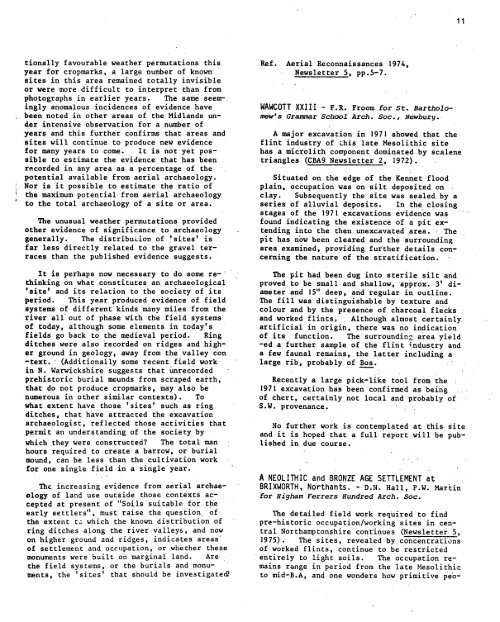Untitled - Council for British Archaeology
Untitled - Council for British Archaeology
Untitled - Council for British Archaeology
You also want an ePaper? Increase the reach of your titles
YUMPU automatically turns print PDFs into web optimized ePapers that Google loves.
, been<br />
; Nor<br />
! the<br />
11<br />
tionally favourable weather permutations this<br />
year <strong>for</strong> cropmarks, a large number of known<br />
sites in this area remained totally invisible<br />
or were more difficult to interpret than from<br />
photographs in earlier years. The same seemr<br />
ingly anomalous incidences of evidence have<br />
noted in other areas of the Midlands under<br />
intensive observation <strong>for</strong> a number of<br />
years and this further confirms that areas and<br />
sites will continue to produce new evidence<br />
<strong>for</strong> many years to come. It is not yet possible<br />
to estimate the evidence that has been<br />
recorded in any area as a percentage of the .<br />
potential available from aerial archaeology.<br />
is it possible to estimate the ratio of<br />
maximum potential from aerial archaeology<br />
to the total archaeology of a site or area.<br />
The unusual weather permutations provided<br />
other evidence of significance to archaeology<br />
generally. The distribuLion of 'sites' is<br />
far less directly related to the gravel terraces<br />
than the published evidence suggests.<br />
It is perhaps now necessary to do some re-'<br />
thinking on what constitutes an archaeological<br />
'site' and its relation to the society of its<br />
period. This year produced evidence of field<br />
systems of different kinds many miles from the<br />
river.all'out of phase with the field systems<br />
of today, although some elements in today's<br />
fields go back to the medieval period. Ring<br />
ditches were also recorded on .ridges and higher<br />
ground in geology, away from the'valley'con<br />
-text. . (Additionally some recent field workin<br />
N. Warwickshire suggests that UnrecOrded<br />
prehistoric burial mounds from scraped earth,<br />
that do not produce cropmarks, may-alio be<br />
numerous in other similar contexts). To<br />
what extent have those 'sites' such as ring<br />
ditches, that have attracted the excavation<br />
archaeologist, reflected those activities that<br />
permit an understanding of the society by<br />
which they were constructed? The total man -<br />
hours required to create- a.barrow, or burial<br />
mound, can be less than the cultivation work<br />
<strong>for</strong> one single field in a single year.<br />
The increasing evidence from aerial archaeolog'y<br />
of land use outside those contexts accepted<br />
at present of "Soils'suitable <strong>for</strong> the<br />
early settlers", Must raise the question, of.<br />
the extent tc, which the known distribution of<br />
ring ditches along the river valleys, and now<br />
on higher ground and ridges, indicates areas'<br />
of settlement and occupation, or whether these<br />
monuments were built on marginal land. Are.<br />
the field systems, or the burials and monuments,<br />
the 'sites' that should be investigate&<br />
Ref. Aerial Reconnaissances 1974,<br />
Newsletter 5, pp.5-7.<br />
WAWCOTT XXIII - F.R. Froom <strong>for</strong> St. Bartholomew's<br />
Grammar School Arch. Soc., Newbury.<br />
A major excavation in 1971 showed that the<br />
flint industry of Lhis late Mesolithic site<br />
has a microlith component dominated by scalene<br />
triangles (CBA9 Newsletter 2, 1972).<br />
Situated on the edge of the Kennet flood<br />
plain, occupation was on silt deposited on<br />
clay. Subsequently the site was sealed,by a<br />
series of alluvial deposits. In the closing<br />
stages of the 1971 excavations evidence was<br />
found indicating the existence of a pit extending<br />
into the then unexcavated area. . The<br />
pit has nbw been cleared and the surrounding<br />
area examined, providing further details concerning<br />
the nature of the stratification.<br />
The pit had been dug into sterile silt and<br />
proved to be small'and shallow, approx. 3' diameter<br />
and 15" deep, and regular in outline.<br />
The fill vas distinguishable by texture and<br />
colour and by the presence of charcoal flecks<br />
and worked flints, Although almost certainly.<br />
artificial in origin, there was no indication<br />
of its function. The surrounding area yield<br />
-ed a further sample of the flint 4ndustry and<br />
a few faunal remains, the latter including a<br />
large rib, probably of Bos.<br />
Recently a large pick-like tool from the<br />
1971 excavation has been confirmed as being<br />
of chert, certainly not local and probably of<br />
S.W. provenance.<br />
No further work is contemplated at this site<br />
and it is hoped that a full report will be published<br />
in due course.<br />
A NEOLITHIC and BRONZE AGE SETTLEMENT at<br />
BRIXWORTH, Northants. - D.N. Hall, P.W. Martin<br />
<strong>for</strong> Higham Ferrers Hundred Arch. Soc.<br />
The detailed field work required to find<br />
pre-historic occupation/working sites in central<br />
Northamptonshire continues (Newsletter 5,<br />
1975). The sites, revealed by concentrations<br />
of worked flints, continue to be restricted<br />
entirely to light soils. The occupation remains<br />
range in period from the late Mesolithic<br />
to mid-B.A, and one wonders how primitive peo-

















